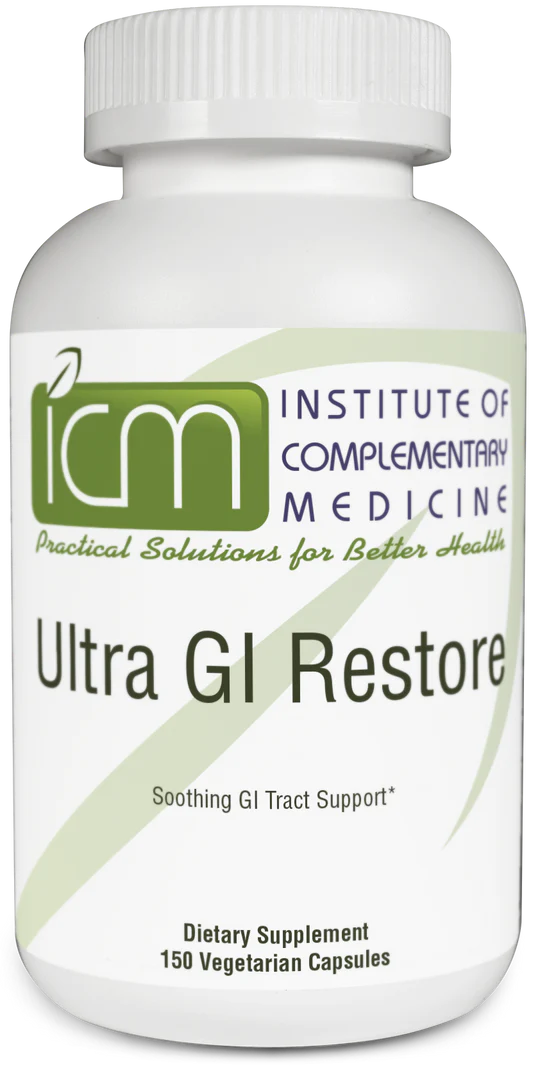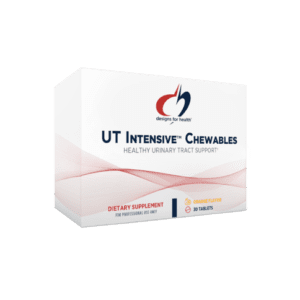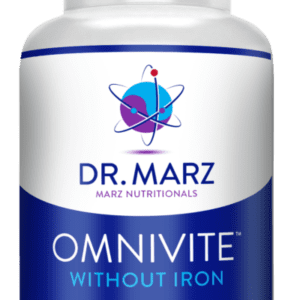Ultra GI Restore Capsules (DGL, GI-Encap)
$81.00
Ultra GI Restore is a feature of a custom blend of botanicals traditionally used to soothe the gastrointestinal tract. The easy-to-mix Ultra GI Restore contains the addition of L-glutamine. These formulas are targeted to support membrane integrity and promote overall digestive health.*
Clinical Applications
• Supports Gastrointestinal Health*
• Supports Mucous Membrane Integrity*
• Promotes Healthy Bowel Function*
Description
The integrity and function of the gastrointestinal (GI) tract is fundamental to vitality. The GI tract is a tube composed of multiple layers that include a mucosal lining of the lumen, sub-layers of mucosa, and a rich supply of nerves and blood vessels in the inner smooth muscle. A healthy gastric mucosal lining protects the GI tract from the damaging effects of stress, bacteria, and other irritating physical and chemical substances.[1] The critical functions of the GI tract are the digestion and assimilation of foods into fuel, sufficient elimination of wastes, and the provision of a barrier for immune protection. These functions render the GI tract as foundational for good health and wellness. Ultra GI Restore are formulated with the goal of promoting good health and wellness, and they contain ingredients clinically and traditionally utilized to support a healthy GI tract.*
Licorice (Glycyrrhiza glabra)
The roots and rhizomes of licorice are used for a wide range of therapeutic applications, including the reported use of enhancing gastric mucus secretions to support GI health. In vitro research suggests that licorice flavonoids have a beneficial impact on Helicobacter pylori (H pylori) activity in the GI tract, and animal studies show that deglycyrrhizinated licorice (DGL) is effective in the alleviation of ulcerated gastric mucosal damage. Human trials in the 1970s also indicate that licorice could be of benefit for gastric ulcerations, popularizing its clinical use in support of GI health.*[2]
GutGard™ is a DGL extract standardized to 3.5% glabridin and 10% total flavonoids. A randomized, double-blind, placebo-controlled study was conducted to evaluate the efficacy of GutGard in subjects (N = 50) experiencing functional dyspepsia. Subjects given 75 mg of GutGard twice daily for 30 days tolerated it well and showed a significant decrease in total symptom scores, suggesting efficacy in the management of functional dyspepsia.[2] Randomized trials have also evaluated GutGard for the management of H pylori load. Subjects (N = 107) received 150 mg of GutGard or placebo once per day for 60 days. A statistically significant difference in H pylori load was found with GutGard being over 70% more efficacious in test subjects when compared to the control group, suggesting that GutGard is effective for the management of H pylori.*[3]
Actazin®
A nutritional ingredient crafted from the nutrient-dense green kiwifruit of New Zealand, Actazin is indicated for routine maintenance of digestive health and symptomatic support for bowel regularity. It consists of a variety of bioactive components, including fiber and polyphenolics, which contribute to its prebiotic activity along with actinidin, the kiwifruit’s unique protein-degrading enzyme.*[4]
In a randomized, double-blind, placebo-controlled study, the effect of two doses of Actazin on stool frequency and form and GI comfort was assessed in healthy and functionally constipated individuals. Low-dose (600 mg/day) and high-dose (2,400 mg/day) Actazin was given for 28 days followed by a 14-day washout period. Participants recorded daily bowel movements and well-being parameters in questionnaires. In the healthy cohort (n = 19), the higher-dose Actazin significantly increased the mean daily bowel movements compared to the washout, and both doses increased bowel movements by more than one per week, demonstrating that Actazin produced clinically meaningful increases in bowel movements in healthy individuals.*[5]
Aloe vera
Anecdotal evidence, experimental studies, and traditional use have suggested that the oral administration of Aloe vera preparations may be useful for a wide range of GI problems, but this has not been a subject of robust clinical investigation.[6,8] Aloe vera latex is the yellowish substance found between the gel and the skin of the aloe leaf. It contains bitter anthraquinone glycosides (such as aloin) for which a laxative effect is well established, yet safety is of concern. The aloe extract used in Ultra GI Restore Powder does not contain latex but only the gel from the inner leaf. The polysaccharide content of aloe gel is thought to be responsible for supporting a healthy inflammatory response in the GI tract.[7,8] In addition, the effects of Aloe vera appear to vary, depending on the duration of use and the individual’s specific symptoms. In a randomized trial, subjects (N = 58) with irritable bowel symptoms were given placebo or a 50 mL dose of Aloe vera (with less than 1 ppm aloin) four times per day for 30 days with symptom assessment at baseline, one month, and three months. The Aloe vera was well-tolerated, and improvement was noted for diarrhea and other mixed symptoms, pain score, and proportion of days with pain. These effects were not sustained off treatment. The authors concluded that although results were not significant, Aloe vera was of benefit and could also be useful to those with constipation, yet longer study periods are needed for an assessment of the effect of Aloe vera on overall symptoms.*[7]
Zinc-Carnosine
A derivative of carnosine in which a zinc ion is chelated with carnosine, zinc-carnosine is a unique compound that appears to enhance mucosal integrity in the stomach. A series of studies were completed in the early 1990s that were intended to assess the effect of zinc carnosine. They included in vitro models of gut injury and repair, in vivo animal models, and a small clinical trial (N = 10). It was concluded that zinc-carnosine played a role in stabilizing gut mucosa.*[9,10]
Zinc-carnosine has been used in Japan since the mid-1990s for individuals experiencing gastric symptoms. The most common dosage in the published research is 75 mg twice daily. In a randomized, double-blind, placebo-controlled trial designed to assess the effect of zinc carnosine in patients (N = 258) with gastric ulcerations, zinc-carnosine and the mucosal protective agent cetraxate hydrochloride were equally effective for enhancing mucosal defenses and providing improvements in gastric ulcer patients.*[11]
Prune Powder
Dried plum (prune) products have a long history of being used to support healthy bowel regularity, and their effect on intestinal motility has been widely evaluated.[12] In a systematic review, researchers reviewed four randomized controlled trials that met the inclusion criteria for an assessment of the effect of prunes on various measures of GI health. In constipated individuals, prunes appeared to be superior to psyllium for improving stool frequency and consistency; however, the evidence for other outcomes and effects in non-constipated subjects was found to be weak. Prunes may be an appropriate intervention for the management of bowel regularity, a conclusion which could benefit from being confirmed by further rigorous research.*[13]
Slippery Elm
Traditionally, the inner bark of slippery elm has been used orally to support GI health. Its supportive mechanism has been attributed to mucilages responsible for demulcent and emollient effects. It is reported to cause stimulation of nerve endings along the GI tract, leading to mucus secretions perceived to be beneficial.*[14,15]
Marshmallow
A high-mucilage–containing ingredient that forms a demulcent gel when consumed orally, marshmallow has been used traditionally in many cultures for various maladies, including the support of intestinal mucosal membranes.*[16]
Chamomile
Chamomile is a botanical widely used traditionally for its internal and external calming effects. In 1984, the German Commission E approved the use of chamomile flower preparations for supporting mild digestive disturbances.*[17]
Cat’s Claw
A woody vine that grows in tropical regions, namely in Central and South America, cat’s claw (Uncaria tomentosa) is used by indigenous people for a wide range of therapeutic uses, including digestive complaints.*[18,19]
Okra
The edible seed pod or fruit of okra is widely used as a food source and for medicinal purposes. The pod contains a soft tissue that exudes a mucilaginous (long-chain polysaccharide) juice when cooked, linking okra’s effectiveness as a demulcent agent to its formation of a soothing film over inflamed mucous membranes. In vitro studies have demonstrated that okra may also help bind excess cholesterol in bile acids.*[20]
N-Acetyl Glucosamine
Glycosaminoglycans attach to mucin to help form a protective barrier in the intestinal epithelium. N-acetyl glucosamine (NAG) is a naturally occurring amino sugar precursor for epithelial glycosaminoglycan synthesis. In vitro experiments have shown that NAG influences biofilm formation of different Escherichia coli strains, which has helped elicit further understanding of the mechanism used to prevent colonization of pathogens in the intestinal mucosa.[21] In an open-label clinical trial of human subjects (N = 34) with IBD who were taking 6 g of NAG daily for 4 weeks, 88% of subjects reported that NAG helped ease related symptoms. Larger, placebo-controlled trials are needed to validate its use in healthy subjects. *[22]
Mucin
Mucins are carbohydrate-rich glycoproteins with a unique molecular structure and chemical properties. As part of the mucosal defensive system, mucins are active on the surface of the GI tract and form a protective barrier to separate bacteria from the intestinal epithelium.*[22,23]
Quercetin
Quercetin is a naturally occurring flavonoid present in various fruits and vegetables as well as in tea and red wine. It exhibits antioxidantepitheliums activity, inhibits the in vitro production of the enzymes cyclooxygenase and lipoxygenase, and plays a role in inhibiting proinflammatory cytokines in cultured cells. Quercetin is also reported to influence intestinal microbiota, enhancing intestinal barrier function.*[24-26]
L-Glutamine (in Ultra GI Restore Powder)
A free-form amino acid, L-glutamine supports gastrointestinal health through its vital role in maintaining mucosal integrity.[27] L-glutamine is also involved in the production of secretory immunoglobulin A in the intestines, contributing to immune barrier function of the intestinal mucosa.[25] The function of glutamine in gut physiology has been well established in the literature for normal and pathologic conditions. It protects cells against apoptosis and cellular stresses, promotes enterocyte proliferation, regulates tight junction proteins, and suppresses proinflammatory signaling pathways.[28] In vitro, animal, and human studies have suggested that L-glutamine may help preserve mucosal structure and limit pathogenic deterioration of gut permeability when stores are depleted due to metabolic stress.*[25,28]
Whether an individual prefers a capsule or a powder, Ultra GI Restore provide supplemental support for soothing the gastrointestinal tract and promoting overall digestive health.*
Directions
Take five capsules daily, or use as directed by your healthcare professional.
Consult your healthcare professional prior to use. Individuals taking medication should discuss potential interactions with their healthcare professional. Not intended for use by children. Do not use if tamper seal is damaged.
Formulated To Exclude
Wheat, gluten, yeast, soy, dairy products, fish, shellfish, peanuts, tree nuts, egg, ingredients derived from genetically modified organisms (GMOs), artificial colors, and artificial sweeteners.
*Follow recommended dosing or use as directed by your healthcare practitioner. Individuals taking medication should discuss potential interactions with their healthcare practitioner prior to use. These statements have not been evaluated by the Food and Drug Administration. These products are not intended to diagnose, treat, cure, or prevent any disease.






